Making a plan
I know that a lot of builders start with a bunch of more-or-less random parts or a nice connection between a few of them and fiddle around with those until they find a shape they like, at which point they decide what it is that they'll build. I don't build like that. I know exactly what I'll build before I start and I often know how I'll build it in quite a lot of detail. I look at pictures of the real aircraft already thinking of how to build it and I make a plan. The plan can include a number of things, but usually involves the following things
- a drawing showing the dimensions of various parts of the aircraft
- a design of how to recreate the shape of the wings
- an idea of what the most difficult bits will be
How detailed the plan is and how much of it I work out on paper differs from aircraft to aircraft. The paper version can consist of a small sketch showing some of the dimensions- but sometimes is pretty elaborate. Here are some examples.
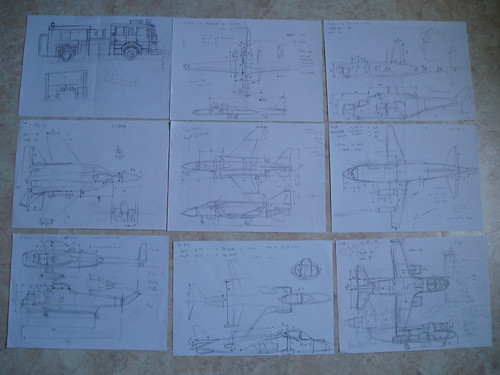
If you look closely you'll see quite a few aircraft and helicopters that I have already built, as well as a fire engine and a few planes I haven't built yet.
I'll now go over the three points on my list in a little more detail, to show a few tricks and the advantages of having them in a plan in the first place.
Working out the dimensions
For finding the dimensions, I tend to use a three-view drawing of the aircraft. I look up its length or wingspan, calculate to how many plate widths those lengths correspond and from that work out to how many studs a cm in the drawing corresponds. I might download and print the plans from the internet and scribble on the printout or use drawings in a book as the basis for my own little drawing. In any case, I like to have a piece of paper next to me when I build. Alexk-, whose F-22 I blogged little more than a week ago, does something similar, but takes a more high-tech approach. Here you see a drawing of the F-22 with a scale superimposed on top of it, showing to how many plate widths the aircraft corresponds.

The shape of the wings
I always spend a lot of time on getting the leading and trailing edges of a wings and the horizontal tail plane the proper angle. Because I tend to build wings using plates (as opposed to using bricks on their side) this usually means using wedge plates. In the last few years, LEGO have introduced a whole range of wedge plates with different angles and often these are enough.

For some aircraft. however, the angle of the leading edge doesn't correspond to anything LEGO make. In that case a bit more creativity is required. Sometimes it is possible to use plate-hinges in combination with different wedge plates to get the proper angle.

Mike Psiaki's F-22, which I also blogged last week also uses the technique, as do the models of the Eurofighter Typhoon built by several people, including my own.
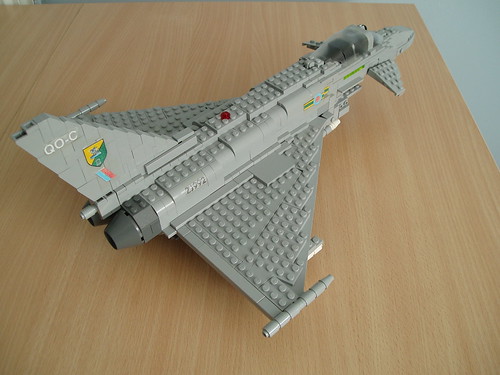
A nice example of a plan, also for a Eurofighter, and with a similar wing design is John Lamarck's.

Sometimes using a little maths can come in handy. I promise not to go overboard on the equations this time, but the Pythagorean theorem can be very useful. It describes the relative lengths of the three sides of right-angled triangles. The sides of triangles with certain angles have integer lengths (phythagorean triples). These can be very useful, because using Pythagorean triples, you can make really sturdy triangles. One example is 3,4,5 (because 32+42=52, I did manage to sneak one equation in here after all).

In other words, the diagonal of a right-angled triangle with sides that are 3 and 4 studs long is exactly five studs long. I used this handy set of numbers to mount the complete wings of my A-7 Corsair at an angle.
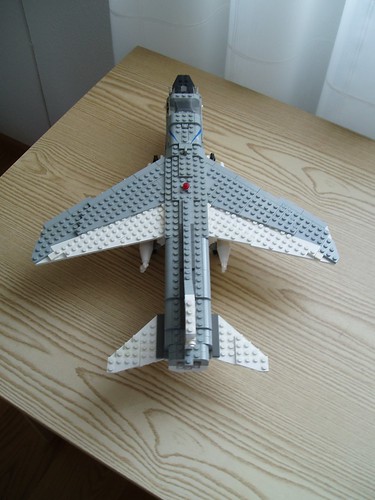
Certainly in the latter case, the way I built the wing had a huge impact on how I built the entire plane. If I hadn't planned this, it would never have worked.
The difficult bits
My plan tends to include some ideas of which bits of the plane will be difficult to build and those are the parts I build first. For my Sea Harrier they were the cockpit section, nose landing gear and the jet intakes.
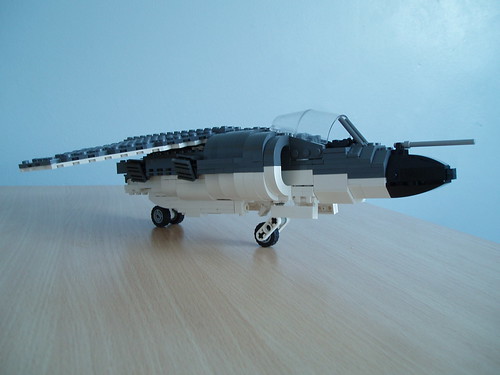
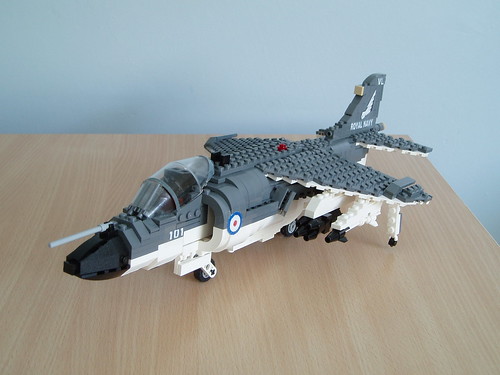
If you look at the completed model, you'll see that the bits that were already present in the work-in-progress picture are still there almost completely unchanged.

Similarly, for my Heinkel He-219 Uhu I started with the cockpit, radar antennae and the engine cowls.
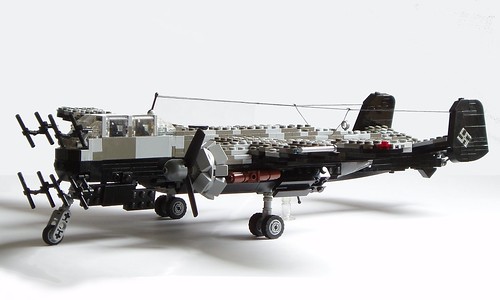
Once the difficult bits are done, the rest of the build tends to be smooth and easy. Having a plan and knowing how big various parts have to be means I rarely rebuild parts of a MOC that I have already built. I also rarely start something that I don't finish.
I love it when a plan comes together!
The plans I drew before building my E-2C Hawkeye are among the more detailed I've done.
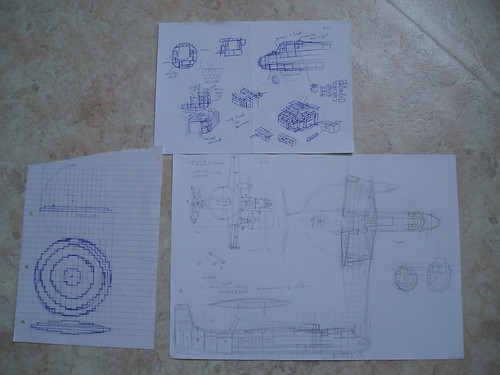
I worked out the dimensions, I designed the outline of the wings, I figured out how to build the nose section and the radome and how the aft fuselage would taper; all before putting any bricks together. If you look closely at the wings you'll see that I've also the technique of combining wedge plates to get the proper angle for the wings. When building it there were still a few things I needed to sort out, but I ended up sticking pretty close to the plan.

Even though it was built more than two years ago, the Hawkeye is still one of my most complicated models and I don't think I could have built it without a plan.
This is not me trying to tell any of you to do things my way. Everybody should build how they see fit. Obviously there are other approaches, but having built a few dozen aircraft models in the last few years alone, I find that this approach is what works best for me. Perhaps some of you can use some of my ideas to your advantage.
Happy building!
Hy Ralph!
ReplyDeleteI´m glad to see you keep writing this articles, they are very interesting and adictive, even though I hardly ever have the patience to plan my models in advance. I usually lost the inspiration if I keep planing then for a long time but not actually building, if you know what I mean.
Bruno Vaiano
Thanks! This will help me building my second version of the Mig-21!
ReplyDeleteLike Vaiano, I'm glad to see more activity on this blog (with high quality articles).
Ezechielle/Imagelego
Thank you for all the comments. I am glad that the blog is appreciated. That knowledge makes continuing worthwhile.
ReplyDeletei really like your harrier
ReplyDeleteThis comment has been removed by the author.
ReplyDeleteHere's our take on the Eurofighter Lego Eurofighter from facebook.com/toptablemodels
ReplyDeleteI like how you plan out every detail before starting your builds.
ReplyDelete